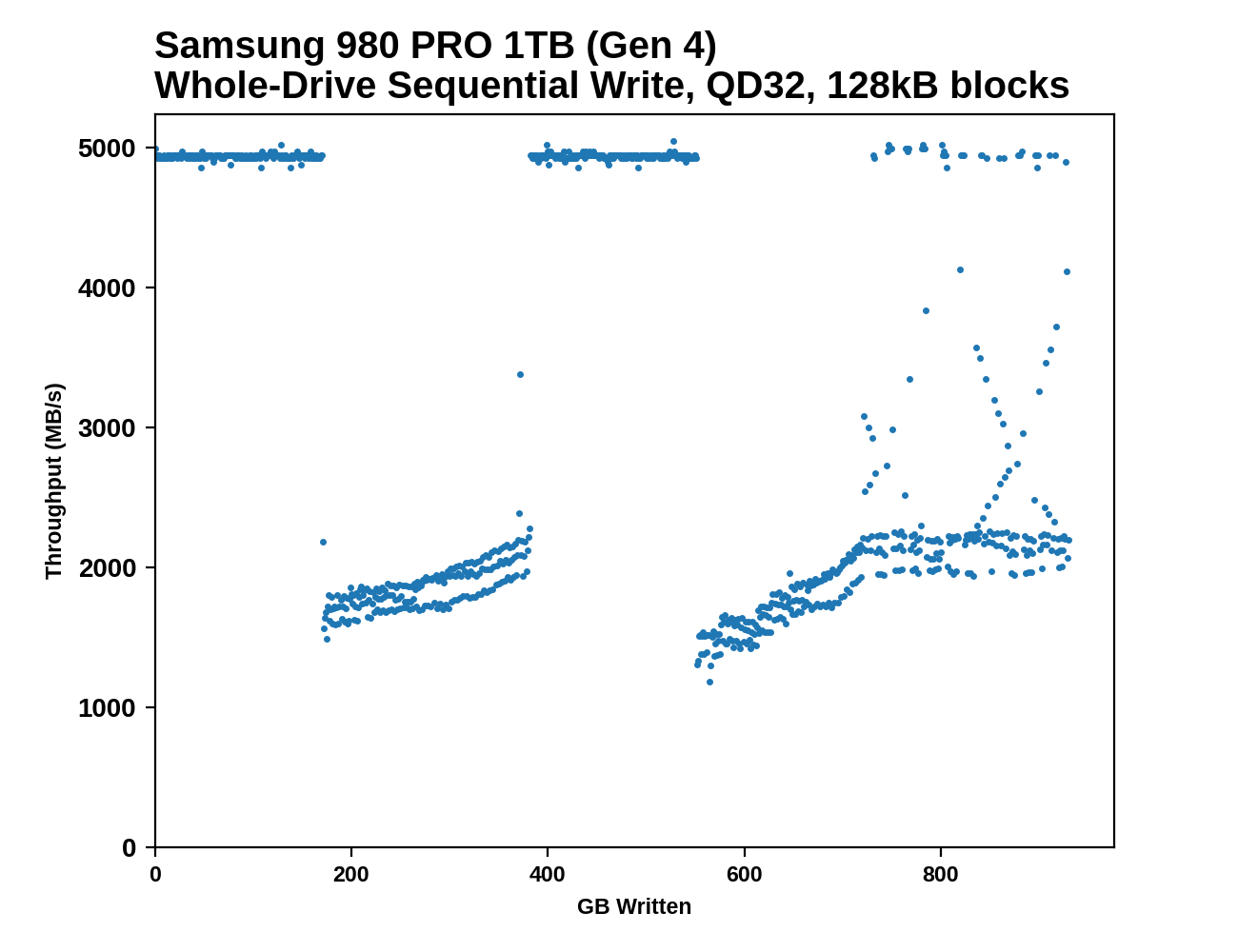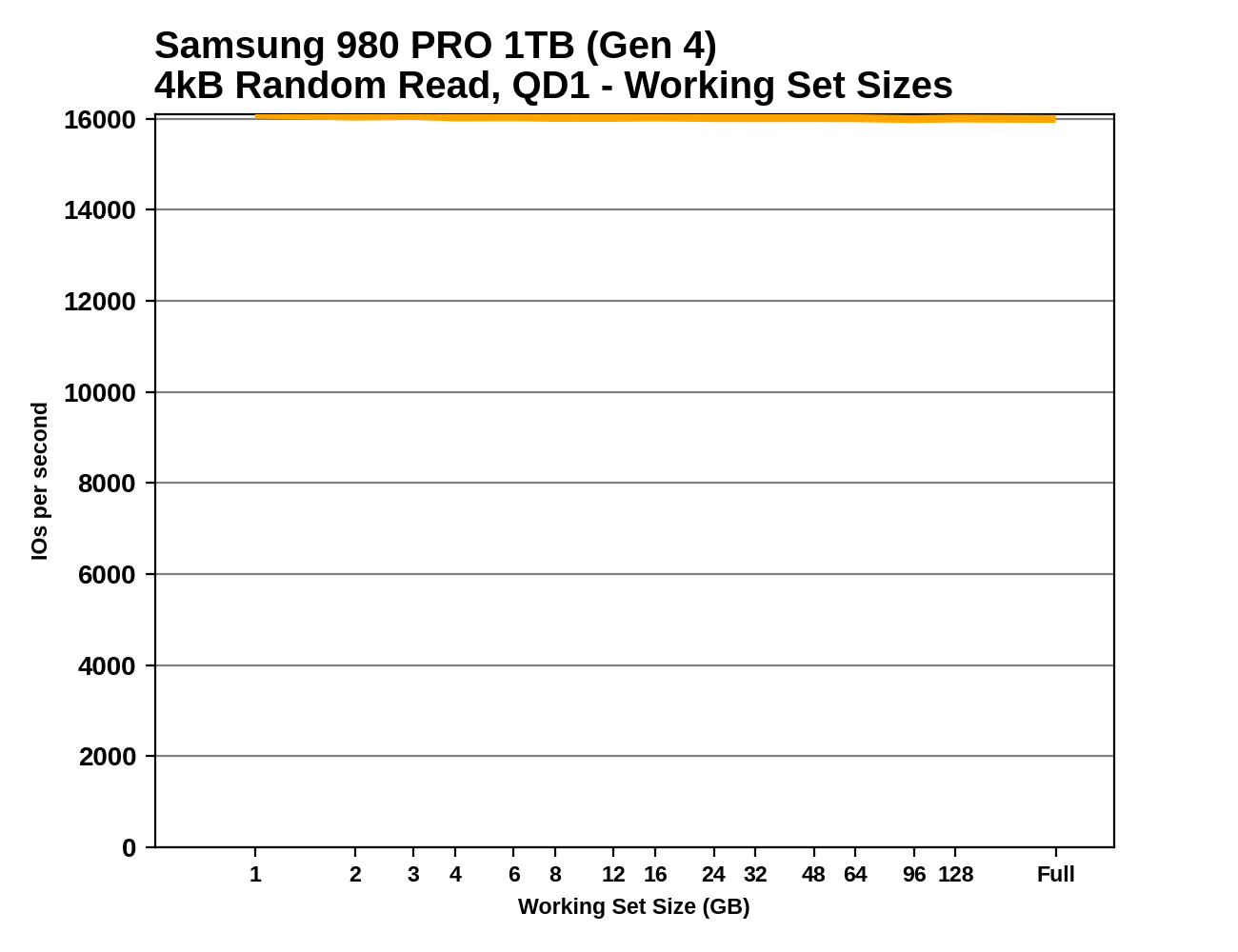The Samsung 980 PRO PCIe 4.0 SSD Review: A Spirit of Hope
by Billy Tallis on September 22, 2020 11:20 AM ESTWhole-Drive Fill
This test starts with a freshly-erased drive and fills it with 128kB sequential writes at queue depth 32, recording the write speed for each 1GB segment. This test is not representative of any ordinary client/consumer usage pattern, but it does allow us to observe transitions in the drive's behavior as it fills up. This can allow us to estimate the size of any SLC write cache, and get a sense for how much performance remains on the rare occasions where real-world usage keeps writing data after filling the cache.
 |
|||||||||
Both tested capacities of the 980 PRO perform more or less as advertised at the start of the test: 5GB/s writing to the SLC cache on the 1TB model and 2.6GB/s writing to the cache on the 250GB model - the 1 TB model only hits 3.3 GB/s when in PCIe 3.0 mode. Surprisingly, the apparent size of the SLC caches is larger than advertised, and larger when testing on PCIe 4 than on PCIe 3: the 1TB model's cache (rated for 114GB) lasts about 170GB @ Gen4 speeeds and about 128GB @ Gen3 speeds, and the 250GB model's cache (rated for 49GB) lasts for about 60GB on Gen4 and about 49GB on Gen3. If anything it seems that these SLC cache areas are quoted more for PCIe 3.0 than PCIe 4.0 - under PCIe 4.0 however, there might be a chance to free up some of the SLC as the drive writes to other SLC, hence the increase.
An extra twist for the 1TB model is that partway through the drive fill process, performance returns to SLC speeds and stays there just as long as it did initially: another 170GB written at 5GB/s (124GB written at 3.3GB/s on Gen3). Looking back at the 970 EVO Plus and 970 EVO we can see similar behavior, but it's impressive Samsung was able to continue this with the 980 PRO while providing much larger SLC caches—in total, over a third of the drive fill process ran at the 5GB/s SLC speed, and performance in the TLC writing phases was still good in spite of the background work to flush the SLC cache.
 |
|||||||||
| Average Throughput for last 16 GB | Overall Average Throughput | ||||||||
On the Gen4 testbed, the overall average throughput of filling the 1TB 980 PRO is only slightly slower than filling the MLC-based 970 PRO, and far faster than the other 1TB TLC drives. Even when limited by PCIe Gen3, the 980 Pro's throughput remains in the lead. The smaller 250GB model doesn't make good use of PCIe Gen4 bandwidth during this sequential write test, but it is a clear improvement over the same capacity of the 970 EVO Plus.
Working Set Size
Most mainstream SSDs have enough DRAM to store the entire mapping table that translates logical block addresses into physical flash memory addresses. DRAMless drives only have small buffers to cache a portion of this mapping information. Some NVMe SSDs support the Host Memory Buffer feature and can borrow a piece of the host system's DRAM for this cache rather needing lots of on-controller memory.
When accessing a logical block whose mapping is not cached, the drive needs to read the mapping from the full table stored on the flash memory before it can read the user data stored at that logical block. This adds extra latency to read operations and in the worst case may double random read latency.
We can see the effects of the size of any mapping buffer by performing random reads from different sized portions of the drive. When performing random reads from a small slice of the drive, we expect the mappings to all fit in the cache, and when performing random reads from the entire drive, we expect mostly cache misses.
When performing this test on mainstream drives with a full-sized DRAM cache, we expect performance to be generally constant regardless of the working set size, or for performance to drop only slightly as the working set size increases.
 |
|||||||||
Since these are all high-end drives, we don't see any of the read performance drop-off we expect from SSDs with limited or no DRAM buffers. The two drives using Silicon Motion controllers show a little bit of variation depending on the working set size, but ultimately are just as fast when performing random reads across the whole drive as they are reading from a narrow range. The read latency measured here for the 980 PRO is an improvement of about 15% over the 970 EVO Plus, but is not as fast as the MLC-based 970 PRO.










137 Comments
View All Comments
romrunning - Tuesday, September 22, 2020 - link
Agreed!Tomatotech - Wednesday, September 23, 2020 - link
See the StoragePro review for some eyebrow-raising numbers that may change your view.https://www.storagereview.com/review/samsung-980-p...
Tams80 - Tuesday, September 22, 2020 - link
What's the point of these if they are going to use TLC? They already make TLC SSDs and the market is pretty full.So what if using MLC is more expensive? Isn't the whole point of these to be their best of the best? And if an SLC cache benefits TLC SSDs, then why not have an MLC SSD with an SLC cache?
Kaziglu Bey - Tuesday, September 22, 2020 - link
Not the hope we're looking for.Time for me to buy another 2TB SX8200 Pro.
vladx - Thursday, September 24, 2020 - link
Yep, beyond enterprise workloads there's no point buying anything other than the SSD with best price/GB.Makaveli - Tuesday, September 22, 2020 - link
What were they thinking here.600 TBW on this "Pro" drive then a small 114GB SLC cache?
The E16 offers 1,800 TBW at 1TB and 333GB SLC cache.
Not impressed with this drive and looking forward to the E18 drives that are slowly coming out.
Luckz - Thursday, September 24, 2020 - link
You mean it will just use the entire empty SSD, because leaving the SSD empty is both a 'feature' and a smart use case? I barely even have 10% free on actively used SSDs.Golgatha777 - Tuesday, September 22, 2020 - link
For $20 more, I'll take a slight performance hit, but gain 4X the endurance by buying a 512GB 970 Pro. There's been nothing worth upgrading to since the 950 Pro when it comes to real world usage anyway though.MDD1963 - Tuesday, September 22, 2020 - link
I've written 30 TB in 3 years to my 960 EVO...; folks worried about 'only' 600 TBW (60 years at my rate usage?) specs are amusing.Makaveli - Tuesday, September 22, 2020 - link
And its assuming to me that you think your anecdotal point speaks for the whole market.